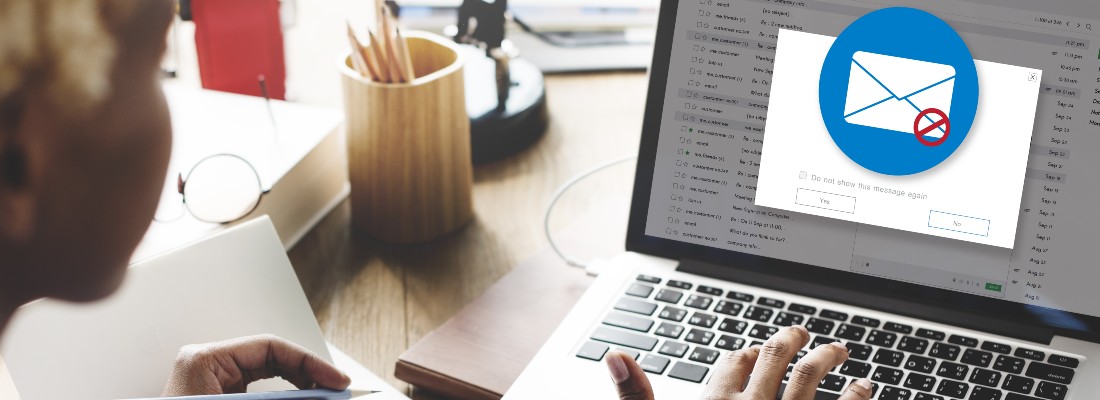
You Should Never Open These 4 Types of Emails
Email remains the main entry point for most cybersecurity attacks today. According to Verizon’s Data Breach Investigations Report, 94% of malware attacks are perpetrated through malicious emails. The question is, are you aware of the form these emails take?
There are four types of emails you should never open. These are emails seeking to confirm your personal data, spoofed emails with a “please do” or “please buy” request, emails claiming your device has been infected with a virus, emails containing ZIP files, invoice attachments, and web links.
These form the easiest entry points for most cyber threats. So let’s break down each of them and learn how you can be safer while receiving and replying to emails on the internet.
The Kind of Emails To Avoid Opening
Despite running a possibly “hacker-proof” network, you and your employees can easily let a cyber criminal inside your network by opening any of these emails.
1. Confirmation of Personal Data
Companies and banks never send emails asking customers and users to confirm their personal data through a form, replying to the email, or following a link provided in the email or some website.
In special cases where they may need you to confirm your personal details or any of your data, they’ll ask you to do it personally in their offices or through the company website.
Other times, the attacker may masquerade their request for personal information through a “Billing Issue” email. These emails often look legitimate and intimidating with a great sense of urgency.
If you ever get this kind of email, log into your member account on the company’s website or call the contact center instead of sharing your personal information via the email or provided link.
Other attackers may also claim that your account is about to expire and that you must sign back in to keep your data. To be sure, don’t follow the link provided in the email. Instead, sign in to the member website directly and confirm whether there may be issues with your account.
2. Spoofed Authority Emails
This is one of the fastest-growing email scams. Reports show that about three billion spoofing emails are sent daily.
A spoofed email appears to have been sent from a legitimate source while it’s been forged by the cybercriminal to perform an attack. The attacker typically generates a similar email address to the trusted source by changing one or two words or letters in the email address that’ll be hard to spot by the receiver.
For instance, if you know sender@example.com, they may spoof that email address by using sender@example1.com. Those are two different email addresses that almost look the same.
Spoofed emails typically ask you to perform tasks such as purchasing gift cards or other generally untraceable, portable currency and sending them to a specific recipient or website.
Since the emails appear to come from an authority such as a bank, e-commerce site, or department in your office, you’re easily convinced to comply.
For spoofed authority emails, there’re always fishy reasons you can’t contact the sender, such as they’re on a plane, in an important meeting, overseas, or the task you have to perform has a tight deadline.
If you observe any of these, ignore the friendly, familiar name, and look closer at the sender’s email address. You’ll notice the subtle differences.
3. Your Device is Infected with a Virus
Generating fear is an effective strategy for getting people to perform specific actions without thinking them through. In technology, the scariest thing for a user is being informed that their system may have been infected with a virus.
Your system can be compromised by malware. However, cybercriminals also use this fear to infect a clean system with malware.
A system infected with malware will often suffer from occasional glitches such as crashes and random hanging. And if you have installed antivirus software, it will alert you if your system is about to be infected or has been infected.
You can never be alerted via email, even by your antivirus service, that your system has been infected by malware.
It is best to delete these emails before opening them. But if you’re in doubt, open them and read the message. But don’t open any links, reply to the email, or download any attachments.
Finally, run a complete system virus scan using your antivirus software to be sure.
4. ZIP Files, Invoice Attachment, Web Links
The unspoken rule of receiving emails is never to open any email attachments unless you know the sender. These include ZIP files, PDFs, music files, video files, purported pictures of family or friends, or vacation destinations.
Emails referencing an unpaid invoice or accounting file also typically come with an attachment containing malware designed to infect your system. These emails are often sent to employees in accounting departments from a spoofed authority email.
The best practice is to delete or avoid downloading attachments from an unknown source. Any file can carry a virus.
Don’t forget that emails don’t need an attachment to be malicious. A mere weblink may lead to a malicious site where your device will be prompted to download and install the malware. Therefore, avoid clicking web links to unknown sources as well.
How to Avoid Email Scams
Combating cyberattacks sent via emails is a complex undertaking. However, there are certain things your organization can do to avoid email scams.
1. Geolocation Filtering
An email sender’s device also sends its geographic location when connected via the internet. You can set up your firewall to block emails from specific regions or countries.
2. Reputation Scoring
Internet Service Providers (ISPs) assign reputation scores to email senders based on the number of emails they send and how many are marked as spam or included in the blocklist, among other factors.
The more a sender’s email is put in these categories, the lower their reputation score. You can use this score to block emails from senders below a certain threshold.
3. Zero Trust Policy
You can implore your workforce to operate with a zero-trust policy regarding emails. Every email received is treated as a possible attack unless proven otherwise.
They can use antivirus software and other tools to scan emails and certify their safety. This method keeps your organization safe despite slowing down the response time for legitimate emails.
Get the Help of Cyber Security Professionals to Secure Your Workplace
Effective email handling techniques will save your business from various malware attacks propagated via email. However, given how fast-paced most attackers are, keeping up may become a struggle.
Get in touch with us for professional cyber security help to secure your emails and close other vulnerabilities in your business.
